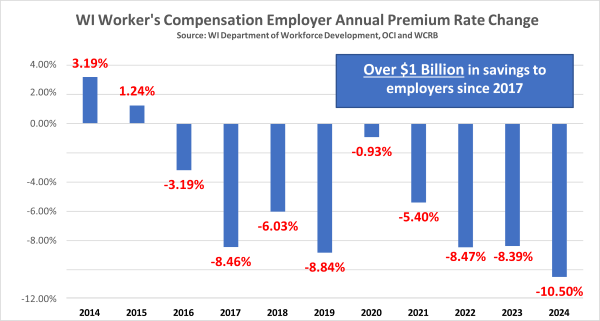Wisconsin’s businesses have reached an important milestone by saving over $1 billion in worker’s compensation premiums since 2017, with the largest reduction in worker’s compensation premiums the state has experienced since at least 2008. The state’s Department of Workforce Development (DWD)
announced on Monday, Aug. 29, that Wisconsin businesses will experience a 10.50% reduction in their worker’s compensation premium rates beginning Oct. 1, 2024 equating to a savings of $206 million in the next year. DWD credited “strong health care networks and return-to-work programs” for Wisconsin’s nation-leading rankings in getting injured workers back on the job – an important statistic to track, particularly for employers during a tight labor market.

While employers have generated significant savings from a system that returns workers back to work faster than nearly every other state in the nation, some have proposed a government fee schedule to slash reimbursement for the very health care providers that are delivering nation-leading results for injured workers. Thankfully, lawmakers have rejected these proposals time and again to protect the system that continues to produce results.
“There are reasons why Wisconsin’s work comp system is a national model,” said Wisconsin Hospital Association President and CEO Eric Borgerding. “Instead of copying systems like Medicaid that strain access and actually cause hospitals and providers to lose money on every patient visit, Wisconsin’s system has remained much more fair for all involved: injured workers can get care quickly, health care providers are paid fairly, and businesses continue enjoying massive reductions in their premiums.”
“Today’s announcement once again emphasizes how our worker’s comp system is win-win for both injured workers and businesses,” said Wisconsin Medical Society Chief Policy and Advocacy Officer Mark Grapentine, who is one of four health care liaisons to the Worker’s Compensation Advisory Council (WCAC). “Cost savings for businesses are great, but let’s not forget that people are getting injured in Wisconsin at a higher rate than the national average. It’s important that we continue to have a system that promotes workers getting quick access to effective care.”
“We hear from our patients who were injured on the job that they are grateful for the excellent health care available to them through the worker’s compensation program,” noted John Murray, CEO of the Wisconsin Chiropractic Association. “Policymakers should be very wary of another government rate-setting process designed to shift money to business despite their reduced premium costs.
“Tinkering with health care payments will cause some providers to reduce their participation in the program,” Murray said. “That’s what the data from other states show so clearly.”
“Rolling the dice with a system that works doesn’t make sense,” added Annie Early, government affairs consultant for the Wisconsin Chapter of the American Physical Therapy Association. “Especially when it puts at risk injured workers’ prompt treatment and care, worker satisfaction, and Wisconsin’s excellent return to work rates.”
For the fourth time in the last five legislative sessions, lawmakers rejected a legislative proposal that would have established a government fee schedule in Wisconsin’s nation-leading worker’s compensation program. While Wisconsin’s health care associations stand ready to discuss the need for real reform in our system, namely the bureaucracy and insurance denials that come along with worker’s compensation cases, we applaud lawmakers for recognizing that the outcomes we receive through the current worker’s compensation system is something that we should protect, not recklessly change.